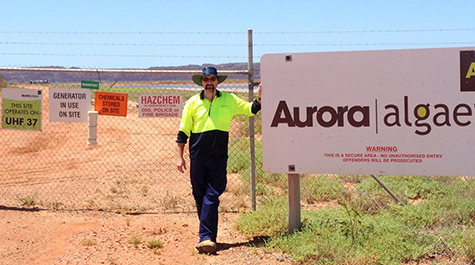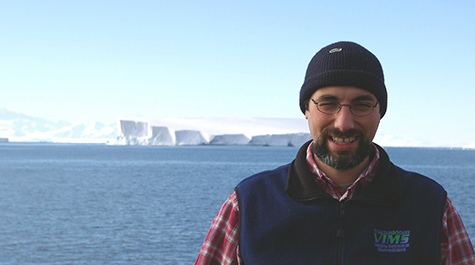VIMS alumnus helps revolutionize algae farming
Dr. Sasha Tozzi has recently transitioned from studying microscopic marine plants to growing them, in an effort to transform farming to meet the needs of humanity’s soaring population.
Tozzi, a 2010 graduate of the Ph.D. program at VIMS, was recently named Vice President of Strain Validation and Field Operations at Aurora Algae, Inc., creators of the world’s first platform for growing marine algae, or phytoplankton, on a commercial scale.
Tozzi, who studied phytoplankton photosynthesis in the Ross Sea in Antarctica for his dissertation research at VIMS, is now collaborating with colleagues at Aurora Algae to grow vast numbers of these single-cell plants in a farm setting for use as nutritional supplements, pharmaceuticals, protein, and renewable fuels.
Tozzi says the background experience he gained from years of studying phytoplankton—also known as microalgae—prepared him to take charge and implement the company’s strain validation program and field operations. “At Aurora, I’m sustainably and economically growing phytoplankton using little more than sunlight, seawater, and carbon dioxide,” he says.
After graduating from VIMS, Tozzi served as a Center for Microbial Oceanography (CMORE) postdoctoral researcher at the Monterey Bay Aquarium Research Institute and at the University of California, Santa Cruz. He then managed a group of researchers as part of a NASA project called the Offshore Membrane Enclosures for Growing Algae (OMEGA).
As the project sites manager for OMEGA, Tozzi supervised the research and development of floating photobioreactor systems for algae-based biofuel production. “Similar to our goals at Aurora Algae, the OMEGA project—which is ongoing—is an innovative method to grow algae, clean wastewater, capture carbon dioxide, and produce biofuel without competing with agriculture for water, fertilizer, or land,” he says.
“My colleagues at Aurora Algae and I take pride in having a sustainable system for growing algae on a very large scale,” adds Tozzi. “We’ve developed the most cost-effective and resource-efficient method for growing, harvesting, extracting, and producing high-quality, algae-derived products.”
Aurora’s current focus is on growing algae as a source of omega-3 fatty acids, heart-healthy compounds now mostly derived from fish. They are also looking at these compounds for use as anti-inflammatories, and additionally use the defatted algae biomass as a source of protein. Addition of algal-derived ingredients is seen as an important way to feed the Earth’s burgeoning human population, which is projected to grow from 7 billion today to 9 billion by 2050. Raising algae with Aurora’s technology is also a much more sustainable, renewable and scalable way to produce feed for farmed fish, cows, chickens, pigs than other more traditional animal feed sources. Even more efficient is converting the algae into products that humans can consume directly.
Tozzi, a native of Italy, gained his early field experiences in the Gulf of Naples, Sicily Channel, and North Adriatic Sea. “I’ve always enjoyed working on innovative projects and establishing effective collaborations and global partnerships,” he says. Those partnerships have involved extensive international travel—including cruises in the Pacific Ocean, Indian Ocean, Southern Ocean, , Atlantic Ocean and Gulf of Mexico.
At VIMS, Tozzi’s research focused on the photobiology of phytoplankton in the Ross Sea, a portion of the Southern Ocean in Antarctica. Along with his academic advisor VIMS professor Walker Smith, Tozzi participated in several research cruises to Antarctica where he amassed a wealth of field experience working on major projects including the VIMS’ Inter-annual Variability in the Ross Sea (IVARS) and Controls of Ross Sea Algal Community Structure (CORSACS).
Funded by the National Science Foundation and headed by Smith, IVARS and CORSACS came to an end in 2007, but Tozzi says the experiences and research accomplishments that came out of both of the programs have greatly influenced his life and career.
Smith says he remembers Tozzi as a tireless worker who always loved going to sea. “Sasha was extremely prepared on the technical side of studying phytoplankton. He was truly an expert on fast repetition fluorometry, and took it upon himself to teach other students the theory and practice of its use,” he says.
Tozzi says his main interests during the IVARS and CORSACS projects were the conditions and processes that lead to phytoplankton blooms in the ocean, and their consequences on regional and planetary scales. He also studied the role iron and light played on blooms of diatoms and Phaeocystis antarctica—two dominant species of algae in the Ross Sea.
“Completing the research for my dissertation at VIMS was an incredible opportunity that has led to countless other opportunities as a result,” says Tozzi. “The projects I worked on as a student allowed me to learn, network, and gain invaluable field experiences that have led me to where I am today.”




